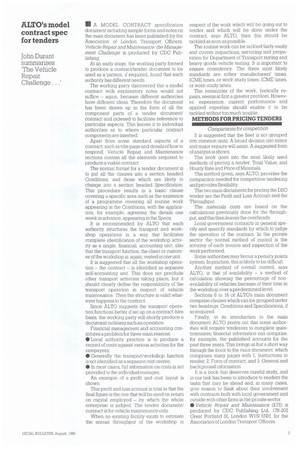ALTO's model contract spec for tenders
Page 95

If you've noticed an error in this article please click here to report it so we can fix it.
John Durant summarises The Vehicle Repair Challenge.
II A MODEL CONTRACT specification document including sample forms and notes on the main document has been published by the Association of London Transport Officers. Vehicle Repair and Maintenance: the Management Challenge is produced by CDC Publishing.
At an early stage, the working party formed to produce a contract/tender document to be used as a pattern, if required, found that each authority has different needs.
The working party discovered that a model contract with explanatory notes would not suffice again, because different authorities have different ideas. Therefore the document has been drawn up in the form of all the component parts of a tender document/ contract and indexed to facilitate reference to particular aspects. This leaves it to individual authorities as to where particular contract components are inserted.
Apart from some standard aspects of a contract, such as title page and details of how to respond, Vehicle Repair and Maintenance sections contain all the elements required to produce a viable contract.
The normal format for a tender document is to put all the clauses into a section headed Conditions, and those which are likely to change into a section headed Specification. This procedure results in a basic clause covering a specific area such as the existence of a programme covering all routine work appearing in the Conditions, with the application, for example, agreeing the details one week in advance, appearing in the Specs.
It is recommended by ALTO that each authority structures the transport and workshop operations in a way that facilitates complete identification of the workshop activity as a single, financial, accounting unit; also that the transport function, the client or customer of the workshop is, again, vested in one unit.
It is suggested that all the workshop operation the contract is identified as separate self-accounting unit. This does not preclude other transport activities taking place, but it should clearly define the responsibility of the transport operation in respect of vehicle maintenance. Then the structure is valid whatever happens to the contract.
Since ALTO suggests the transport operation functions better if set up on a contract-hire basis, the working party will shortly produce a document outlining such an operation.
Financial management and accounting constitutes a problem for three main reasons, • Local authority practice is to produce a record of costs against various activities for the ratepayers; • Generally the transport/workshop function is not identified as a separate cost centre; • In most cases, full information on Costs is not provided to the individual manager.
An example of a profit and cost layout is shown.
This profit and loss account is total in that the final figure is the one that will be used on return on capital employed by which the whole enterprise is judged, The tender document/ contract is for vehicle maintenance only.
When no existing facility exists to estimate the annual throughput of the workshop in respect of the work which will be going out to tender and which will be done under the contract, says ALTO, then this should be tackled as soon as possible.
The routine work can be tackled fairly easily and covers inspections, servicing and preparation for Department of Transport testing and heavy goods vehicle testing. It is important to ensure consistency. The three most likely standards are either manufacturers' times, ICME times, or work-study times, 1CME times, or work-study times.
The remainder of the work, basically repairs, seems at first a greater problem. However, experience, current performance and applied expertise should enable it to be tackled without too much trouble.
METHODS FOR PRICING TENDERS Comparisons for competition It is suggested that the fleet is not grouped into common units. A broad division into minor and major repairs will assist. A suggested form of analysis is shown.
The book goes into the most likely used methods of pricing a tender: Total Value; and Hourly Rate and Price of Materials.
The method given, says ALTO, provides the comparison needed for competitive tendering and provides flexibility.
The two main documents for pricing the DSO tender are the Profit and Loss Account and the Throughput.
The materials costs are based on the calculations previously done for the throughput, and this then leaves the overheads.
Local government contracts in general specify and quantify standards by which to judge the operation of the contract. In the private sector the normal method of control is the scrutiny of each invoice and inspection of the work performed.
Some authorities may favour a penalty points system. In practice, this is likely to be difficult.
Another method of overall control, says ALTO, is that of availability a method of calculation showing the percentage of nonavailability of vehicles because of their time in the workshop over a predermined level.
Sections 6 to 16 of ALTO's main document comprise clauses which can be grouped under two headings: Conditions and Specifications, if so required.
Finally, in its introduction to the main document ALTO points out that some authorities will require tenderers to complete questionnaires, financial information can comprise, for example, the published accounts for the past three years. This brings us but a short way through the book to the main document, which comprises many pages with 1, Instructions to tender; 2, Form of contract: and 3, General and background information,
It is a book that deserves careful study, and in our task has been to introduce to readers the tasks that may lie ahead and, in many cases, give reason to think about their involvement with contracts both with local government and outside with other firms in the private sector.
• Vehicle Repair and Maintenance (£75) is produced by CDC Publishing Ltd, 178-202 Great Portland St, London WIN 6NH, for the Association of London Transport Officers.




































































































